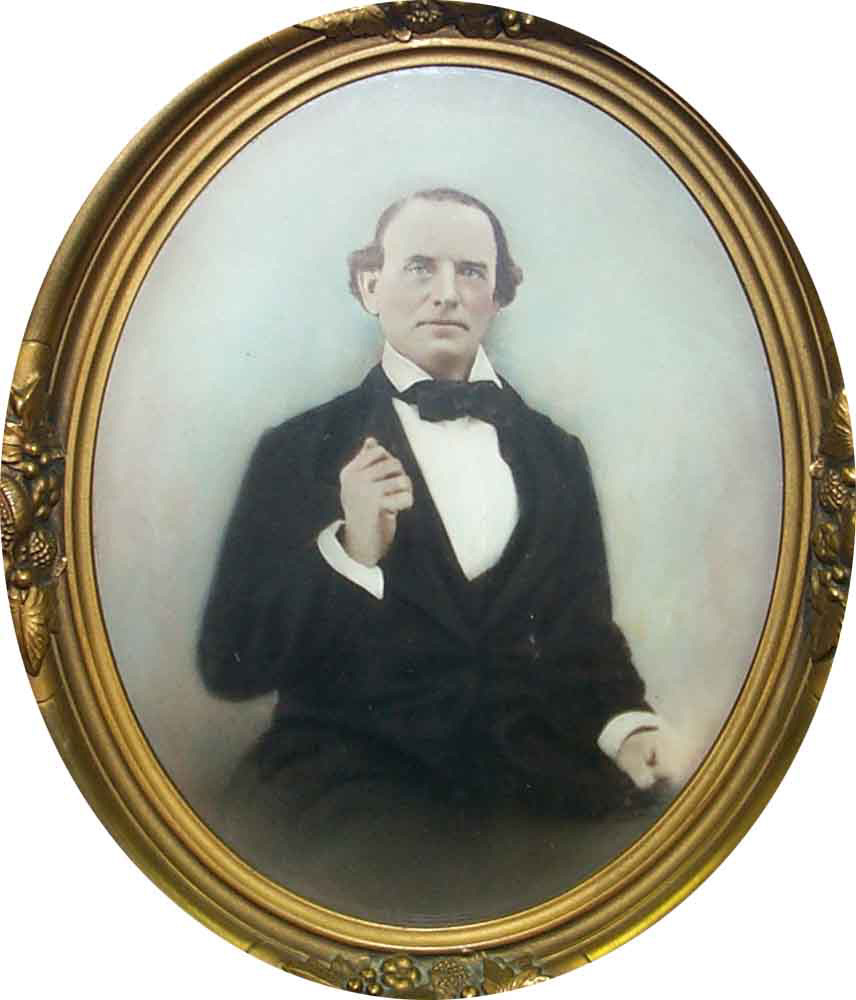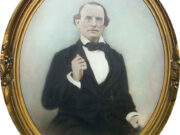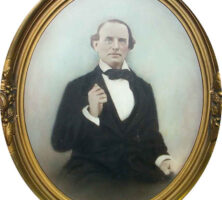John D. Gray was the first major railroad contractor in the South. As John D. Gray and Company, he and his brother William C. Gray constructed railroads in Georgia, Alabama, Mississippi, Louisiana, Florida, North Carolina, and Tennessee. In addition, Gray was a versatile manufacturer for the Confederacy during the Civil War (1861-65).
John David Gray was born in 1808 in London, England, to Elizabeth Granger and Thomas Gray. The family immigrated to the United States when John was young. Gray married Ann Amelia Gnech, and they had four children, two of whom, Charles and Arthur, lived to adulthood. After his wife’s death in 1855, Gray married Mary Jane Moore, and they had five children. Four of these children, Oscar David, George Thomas, Anna Leila, and Jane Carolina, lived to adulthood.
Railroad Construction
The Gray brothers began their enterprising careers in the 1820s on the frontier of railroad construction and manufacturing in Columbia, South Carolina, working in the internal improvements movement. They built sections of a state road and many public buildings in South Carolina, including the Orangeburg courthouse and jail, the jail in Lexington, and the Lunatic Asylum (designed by Robert Mills, one of the first American architects) in Columbia. They owned a steamboat line that operated on the canal system in South Carolina in the mid-1830s. Gray’s company received the major contract for the construction of the South Carolina Railroad, the first railroad in the South.

Courtesy of Nancy Eubanks
Gray built three of Florida’s four territorial railroads, the Lake Wimico and St. Joseph Railroad, the Iola and St. Joseph Railroad, and the Tallahassee Railroad. He was also a key figure in the boomtown development of St. Joseph. After the town experienced a rapid decline due to an epidemic of yellow fever, Gray removed the railroad tracks and used them on a line in Georgia.
The Gray Company’s efforts in Georgia began when the Monroe Railroad (later the Macon and Western) brought Gray to Macon to manage the company. He became president of the railroad and finished the route to Griffin and most of the grading to Atlanta. His company constructed the bulk of the Western and Atlantic Railroad from Dalton to Chattanooga, Tennessee, including the tunnel through Chetoogeta Mountain, the first extensive railroad tunnel in the Southeast. Gray was the prime mover and contractor of the Atlanta and West Point Railroad and the Augusta and Savannah Railroad. He built sections of the Muscogee Railroad, the North and South Railroad to Rome, the Mobile and Girard, and the Upson County Railroad.
In Alabama, Gray built the Opelika, Alabama, to Columbus, Georgia, branch of the Montgomery and West Point Railroad and the seventy-foot railroad cut, reputed to be one of the deepest railroad cuts in the world at the time, at Brock’s Gap on the South and North Alabama Railroad. Gray constructed the line of the East Tennessee and Georgia Railroad from Cleveland, Tennessee, to Chattanooga as well as the tunnel through Missionary Ridge. He also worked on the Mississippi Central Railroad and many others.
Manufacturing
In manufacturing enterprises Gray incorporated with other partners the Saluda Manufacturing Company, a South Carolina textile mill. He purchased land in north Georgia on South Chickamauga Creek and established a company town (Graysville, in Catoosa County), combining mining, manufacturing, agriculture, and transportation. His Graysville Mining and Manufacturing Company mined and processed lime, and he built a large furniture factory, a distillery, a barrel factory, and a large gristmill.
When the Civil War began in 1861, Gray was one of the first to manufacture guns in Georgia, under the names of John D. Gray and Company and the Columbus Armory at Columbus. He turned his furniture factory in Graysville into a war manufacturing establishment, and he established the Montgomery Rolling Mill to further the cause in Alabama. A versatile Confederate manufacturer, Gray produced carbines, Mississippi rifles, Enfield rifles, muskets, sabers, knives, canteens, buckets, poles, gunstocks, bayonet-scabbards, pick axes, shovels, cookware for the field, kettles, nests of tubs, castings, trace chains, axes, pole slides, and tent buttons. He led in the manufacture of “Joe Brown” pikes—poles with sharp blades named for Governor Joseph E. Brown, who ordered them—for the state of Georgia. He owned and developed the Chatata Lead Mines near Charleston, Tennessee, for the Confederate government.
Gray initially assisted in the private establishment of the niter works at a cave in Kingston, in Bartow County, which was later taken over by the Confederate Ordnance Department. At the request of the Confederate Railroad Department, Gray surveyed iron and coal supplies in Alabama and Georgia and manufacturers capable of casting iron for use in constructing railroad cars. Union soldiers destroyed all his assets in Graysville in late 1863 and all of his manufacturing establishments in Montgomery, Alabama, and in Columbus in 1865.
After the war Gray reconstructed the Dillingham Street Bridge in Columbus that had been destroyed during the war. With the profit he incorporated the Atlanta Mining and Rolling Mill Company, which was financed in part by railroads. He continued to construct railroads, rebuilt Graysville, and worked on large and important projects up to the last years of his life. He died in Graysville on November 17, 1878.





